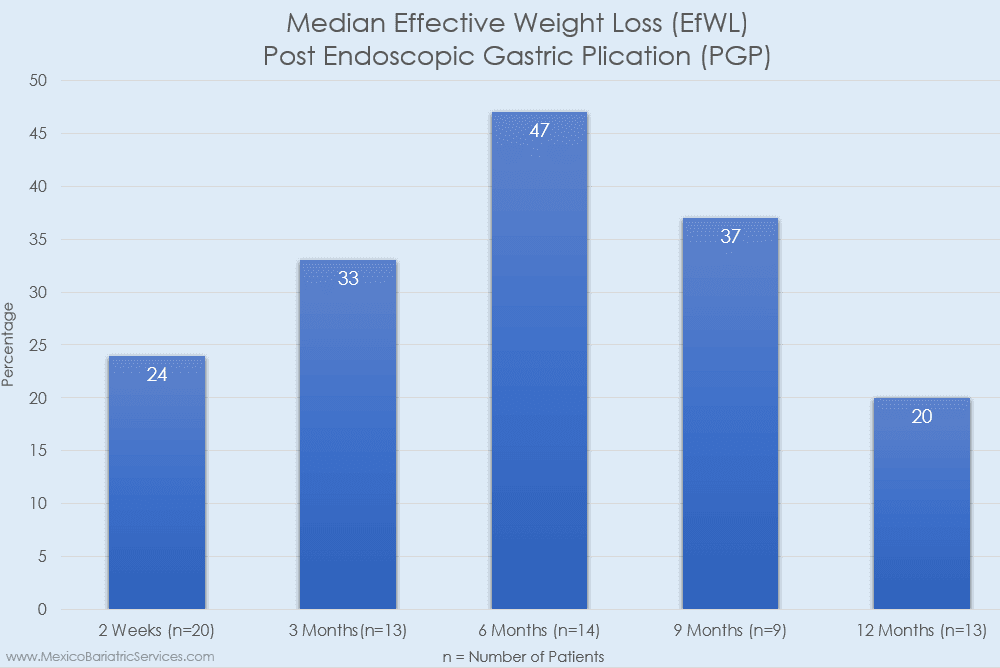16 Revision Bariatric Surgery in Mexico
A Revision Bariatric Surgery in Mexico or a conversion bariatric surgery can help you reverse the weight regain process after your previous WLS surgery.
Reverse your weight gain quickly & safely!
Connect nowHere is Erica Jahner’s transformation after revision bariatric surgery in Mexico.

Before & After Revision Bariatric Surgery in Mexico
Revision Surgery
Is performed if:-
- You are unable to lose excess body weight post-bariatric surgery or,
- You have regained significant weight after weight loss surgery[1]The Center for Surgical Weight Loss at Lake Norman
Revision and Conversion Surgery
“If you had gastric bypass surgery …..”
View in Article
Conversion Surgery
Is performed if:-
- Your stomach-jejunum conjoining widens or,
- Your gastric pouch enlarges, leading to poor weight loss and weight regain after surgery or,
- Your band port malfunctions where either the gastric band erodes or slips and needs to be removed. In such cases, weight regain is likely.[1]The Center for Surgical Weight Loss at Lake Norman
Revision and Conversion Surgery
“If your laparoscopic adjustable gastric is…”
View in Article
**Please note: In medical terminologies, revision and conversion surgeries are two different procedures; however, these are commonly used interchangeably nowadays. This page also uses both these terms interchangeably to comply with the universal language.
Gastric Bypass Revision
Weight regain after gastric bypass surgery is a potential outcome that can pose a threat to your physical and mental well-being. To reduce the post-op regained weight, Gastric Bypass “tune-ups” or surgical revision is required.
There are many ways in which a gastric bypass is revised.
Procedures:
1. Transoral Outlet Reduction (TORe)
This surgery reduces the size of your gastric outlet using an endoscopic suturing device which inserts stitch into it.
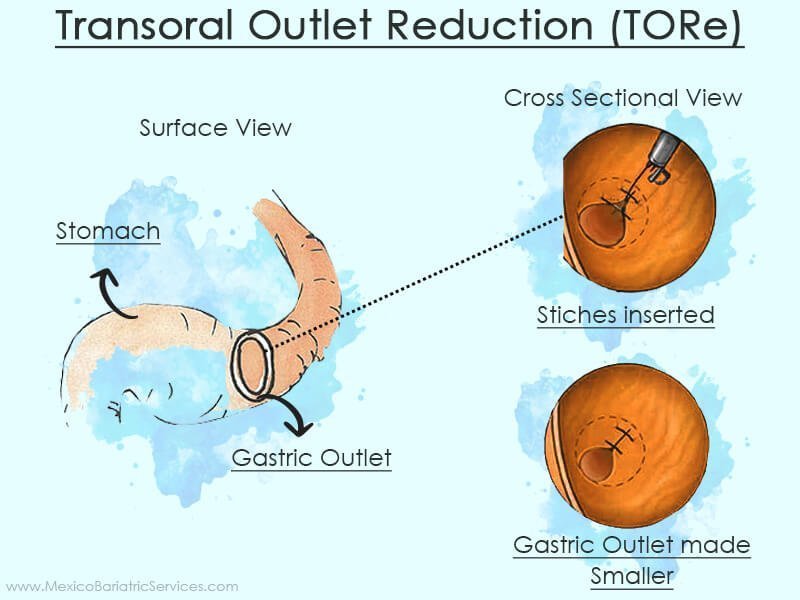
Success rate: A research carried out to determine the safety and feasibility of TORe and to monitor the total weight loss after the revision showed a technical success rate of 100%.[2]Jirapinyo P, Kröner PT, Thompson CC
Purse-string transoral outlet reduction (TORe) is effective at inducing weight loss and improvement in metabolic comorbidities after Roux-en-Y gastric bypass.
“…The technical success rate was 100%…”
View in Article
Risks: Although many studies and surgeons approve of this procedure patients are at mild risk of weight gain, perforation, and high chances of re-operation.[3]Vincenzo Bove
Transoral Outlet Reduction for Therapy of Weight Regain After Gastric Bypass.
“…while one patient (5.2%) had gastric perforation…”
View in Article
This revision is not performed in Mexico because the Mexican FDA does not approve of the Endoscopic Suturing Device used in the surgery.
2. Gastric Bypass To Sleeve Gastrectomy
During this kind of revision, the surgeons remove some portion of the pouch to restrict food intake.
This revision surgery is for patients who go through dumping syndrome, and it also resolves low blood sugar levels in patients from a previous bypass.
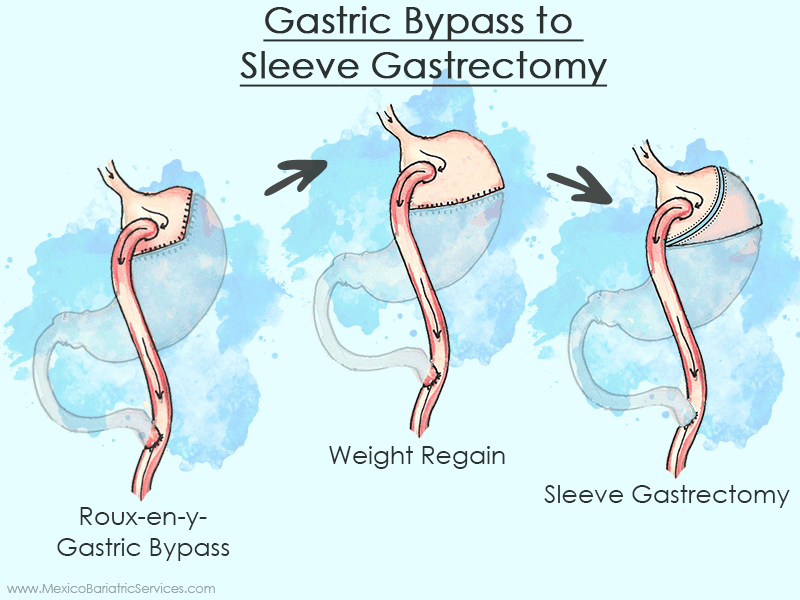
Success rate: A study suggests that this conversion significantly improves malnutrition and maintains weight loss at early follow-ups.[4]Chung-Yen Chen, Wei-Jei Lee, Hui-Ming Lee
Laparoscopic Conversion of Gastric Bypass Complication to Sleeve Gastrectomy: Technique and Early Results
“…significant improvements in malnutrition…”
View in Article
Risks: This conversion has a high rate of significant complications along with high rates of readmission and need for supplemental nutrition.[5]Carter CO, Fernandez AZ, McNatt SS, Powell MS.
Conversion from gastric bypass to sleeve gastrectomy for complications of gastric bypass.
“However, conversion has a high rate…”
View in Article Also, a failed gastric bypass, in most cases, cannot be converted into Gastric Sleeve. It is because the stomach is already reduced to a small pouch in the former.
3. Gastric Band on Gastric Bypass
This is a modification surgery and is done by placing an adjustable band on the stretched pouch. It creates fullness even when small portions of food are consumed.
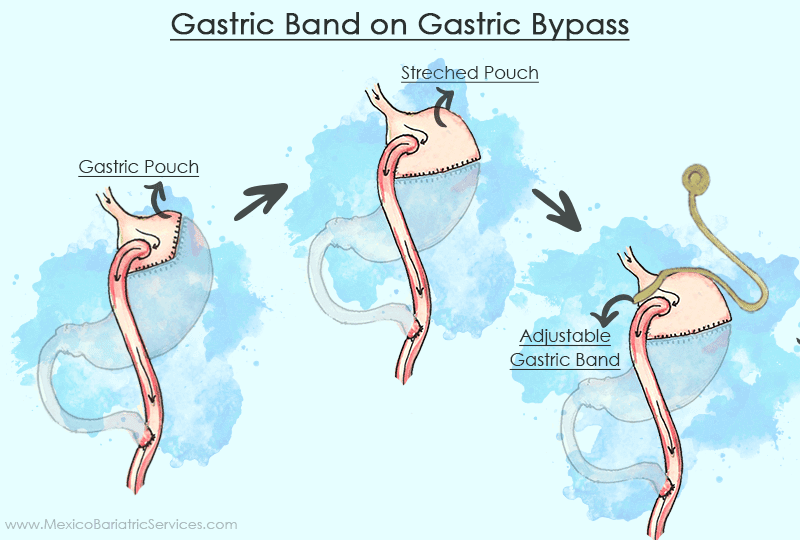 Success rate: This procedure is low risk, requires no stapling and has an excellent safety record.[6]Obesity Action Coalition
Success rate: This procedure is low risk, requires no stapling and has an excellent safety record.[6]Obesity Action Coalition
Band over Bypass
“It has been well established that the LAGB…”
View in Article
Risks: In rare cases, the band can erode into the gastric pouch, which makes its removal mandatory.
4. Gastric Bypass to Gastric Pouch Plication (Endoscopic)
It is a newer weight loss surgery technique. It reduces the size of the stomach by folding it inward, followed by stitching of the fold.
The procedure does not reroute the intestines, but the broad folds of gastric pouch tissues are drawn into the StomaphyX chamber.
After that, plications (folds) are created, and fasteners are deployed. As an end result, the pouch size shrinks with a marked decrease in the patient’s weight.
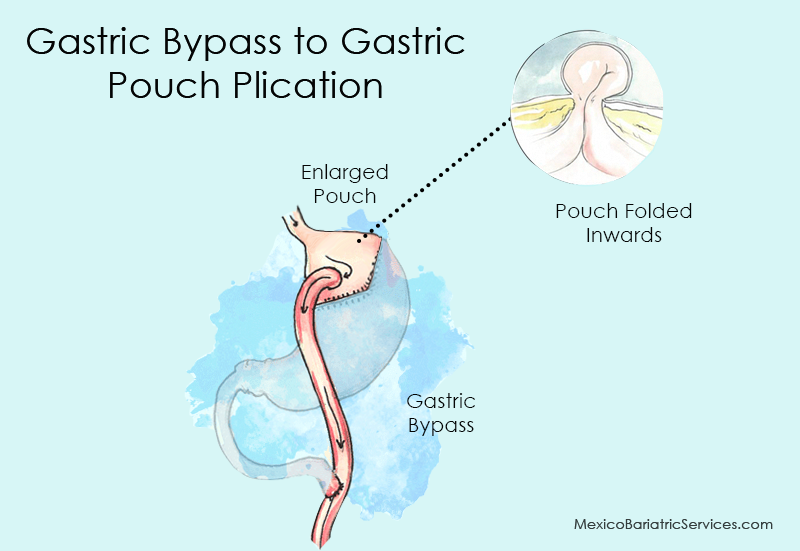
Success rate: Weight loss is maximal during the first six months with 19.5 % EWL at 1-year follow-up, it has been reported to decrease on long-term follow-up. Both the pouch and stoma tend to regain their pre-procedure size.[7]Ibtisam Al-Bader, Mousa Khoursheed, corresponding author Khalid Al Sharaf, D. Ali Mouzannar, Aqeel Ashraf, and Abe Fingerhut
Revisional Laparoscopic Gastric Pouch Resizing for Inadequate Weight Loss After Roux-en-Y Gastric Bypass
“Although weight loss is maximal during the first…”
View in Article
Risks: If done by an inexperienced surgeon, then problems like bleeding and perforation may come up.
5. Sclerotherapy to shrink stoma
The more massive the outlet of joining between your stomach and the intestines (GJ Anastomosis), more weight regain you can have.
During the treatment, the doctor will inject Sodium Morrhuate into the rim of the enlarged GJ anastomosis. An endoscopic sclerotherapy needle is used for the process. A scar forms that help in shrinking the stoma in some months.
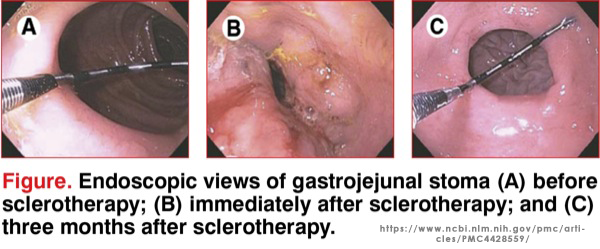
Success rate: A significant 90% of patients who underwent this procedure stabilized their weight regain after 12 months of their gastric bypass. Endoscopic sclerotherapy appears to be a safe and effective tool for the management of weight regain after Roux-en-Y Gastric Bypass (RYGB).[8]Barham K. Abu Dayyeh, Pichamol Jirapinyo
Endoscopic Sclerotherapy for the Treatment of Weight Regain after Roux-en-Y Gastric Bypass: Outcomes, Complications, and Predictors of Response in 575 Procedures
“Endoscopic sclerotherapy appears…”
View in Article
Risks: The study also showed risks like bleeding and transient diastolic blood pressure but without adverse health outcomes. Moreover, no gastrointestinal perforations were reported.[8]Barham K. Abu Dayyeh, Pichamol Jirapinyo
Endoscopic Sclerotherapy for the Treatment of Weight Regain after Roux-en-Y Gastric Bypass: Outcomes, Complications, and Predictors of Response in 575 Procedures
“Bleeding was reported in 2.4%…”
View in Article
6. Lengthen the Roux-limb (Bypass Tune-Up)
A roux limb is an intestinal segment which becomes the primary food recipient after surgery. When a gastric bypass surgery is done, the added roux limb is usually 45 cm to 100 cm in length.
By lengthening the limb to 150cm or greater (<200 cm), insulin sensitivity is increased. This helps in maintaining healthy blood sugar, energy levels, and proper body composition.
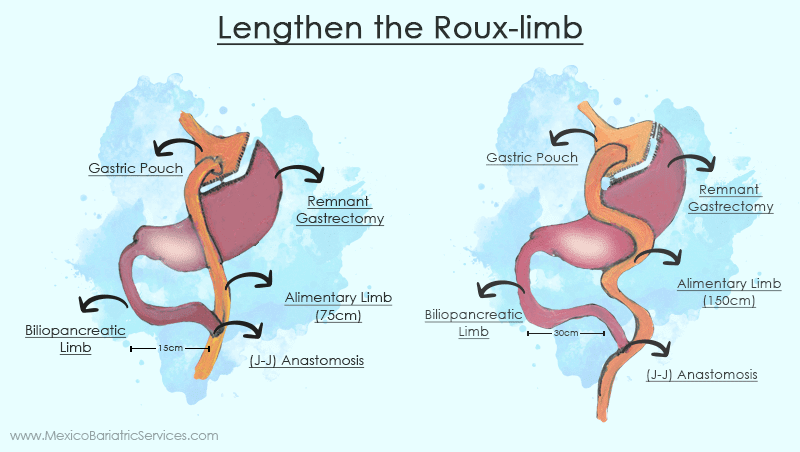
Success rate: As per a study, no significant technical or metabolic complications were reported. Approximately 6% extra weight loss without diarrhea was observed after doubling the length of the standard Roux-Y limb.[9]Bruder SJ, Freeman JB, Brazeau-Gravelle P.
Lengthening the Roux-Y Limb Increases Weight Loss after Gastric Bypass: a preliminary report.
“Doubling the length of the standard Roux-Y…”
View in Article
Risks: As stated by some doctors, themalnutrition riskinvolved is really high, and so this procedure is avoided.
7. Gastric Bypass to Duodenal switch
(Pancreatic Diversion with Duodenal Switch)/the duodenal switch, a combination of the Gastric Sleeve and a Bypass of the intestines, demonstrates the best weight loss.
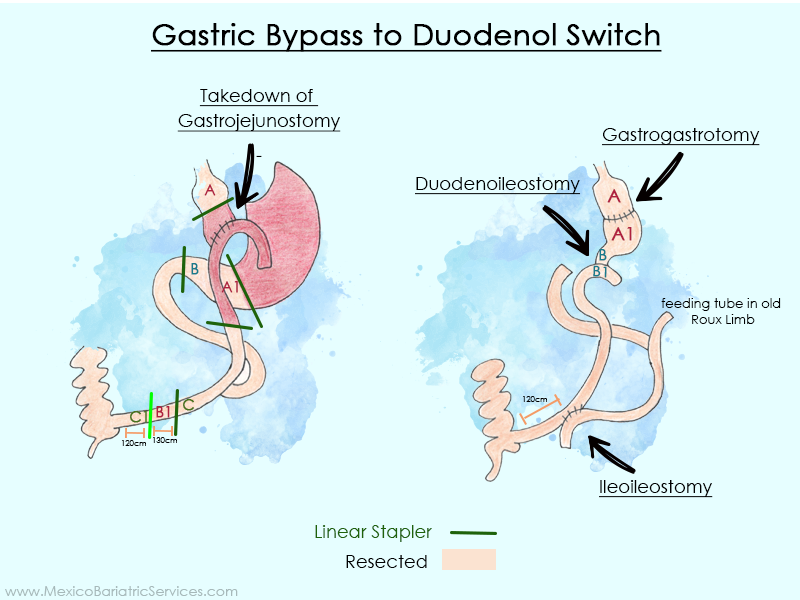
Success rate: According to an analysis, the laparoscopic conversion of failed Roux-en-Y gastric bypass to Duodenal Switch is highly effective with acceptable morbidity.[10]Manish Parikh, Michel Gagner
Laparoscopic Conversion of Failed Gastric Bypass to Duodenal Switch
“…laparoscopic conversion of failed RYGB…”
View in Article
Risks: The most common complication observed during the process is of gastrogastrostomy, although it responds to a single episode of endoscopic dilation.[10]Manish Parikh, Michel Gagner
Laparoscopic Conversion of Failed Gastric Bypass to Duodenal Switch
“The most frequent complication …”
View in Article
8. ROSE (Restorative Obesity Surgery)
After Roux-en-Y gastric bypass, the stomach and its opening to the small intestine (stoma) are kept at a very small size. However, this opening can stretch with time, allowing patients to ingest more. Hence, weight regain!
This revision surgery is performed endoscopically and creates huge folds inside the stomach on multiple repetitions. The suture anchors go deep into the tissue to maintain its durability. As a result, the pouch regains its original post-op size.

Success rate: Various studies have been conducted to ensure the success of the ROSE procedure. A survey conducted under Mullady et al. reported technical progress in 85% of the cases while Ryou et al. reported a 100% success.[11]Marvin Ryou, Christopher C. Thompson
Current Status of Endolumenal Bariatric Procedures for Primary and Revision Indications
“Mullady et al reported technical success…”
View in Article
Risks: No significant complications have been reported for this procedure as of now.
Gastric Sleeve Revision (LSG)
People may gain weight with their previous gastric sleeve surgeries. After a thorough check-up, the doctor may suggest gastric sleeve revision surgery in Mexico.
A study observed a gastric sleeve for a year. The volume of the sleeve enlarged from 81.9 ml to 196.2 ml after a year, which needed correction later on.
The multi-slice computed tomography shows initial and the final images of the malfunctioned sleeve. The patient was given a radio-opaque dye so that it becomes visible in the scan.
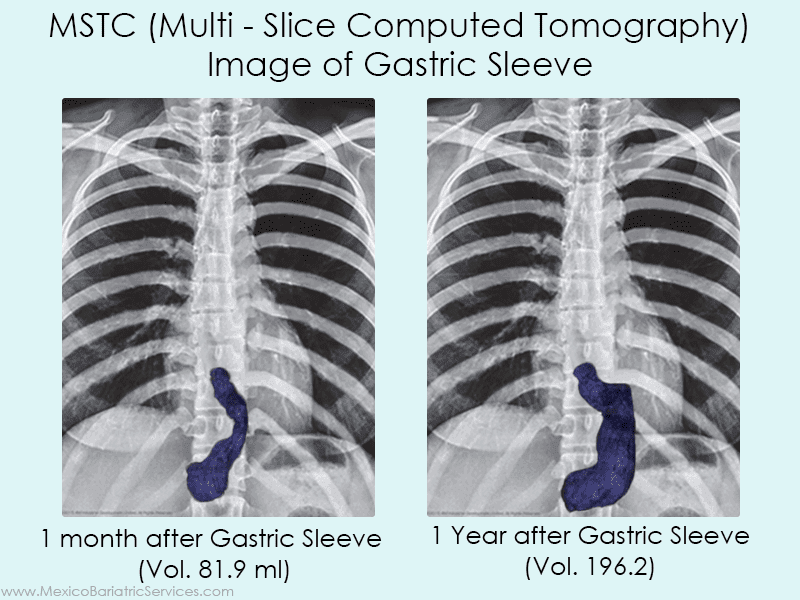
There are several procedures with which a malfunctioning gastric sleeve can be revised.
Procedures:
1. Re-Sleeve Gastrectomy
Patients with super obesity (BMI>50) are treated with re-sleeve surgery in Mexico.
.
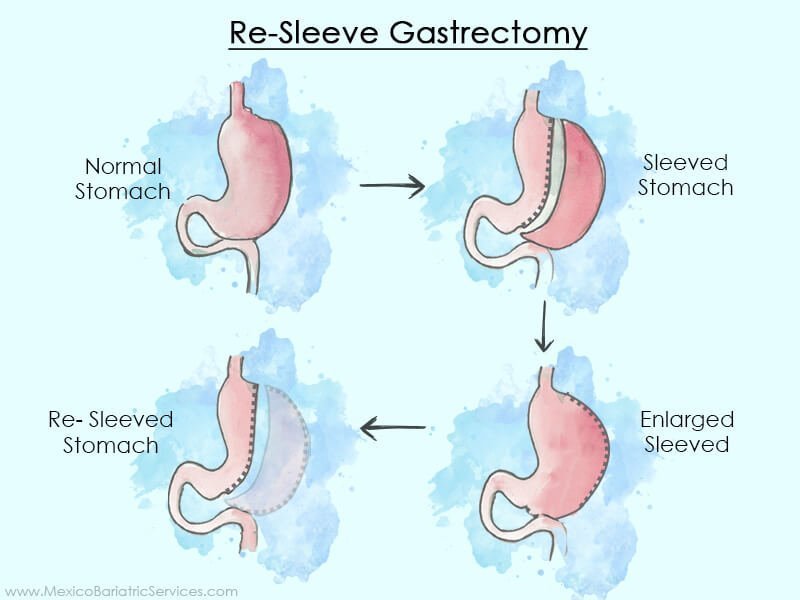
Success rate: A follow-up study on 11 patients who have undergone a re-sleeve surgery showed that none of the cases showed intra-operative or postoperative complications.[12]Giovanni Cesana, Matteo Uccelli, Francesca Ciccarese
Laparoscopic re-sleeve gastrectomy as a treatment of weight regain after sleeve gastrectomy
“In all cases, neither intra-operative …”
View in Article
Moreover, laparoscopic re-sleeve gastrectomy was deemed feasible and effective to correct weight regain after sleeve.[12]Giovanni Cesana, Matteo Uccelli, Francesca Ciccarese
Laparoscopic re-sleeve gastrectomy as a treatment of weight regain after sleeve gastrectomy
“Laparoscopic re-sleeve gastrectomy is a feasible and…”
View in Article
Risks: The sleeve may re-stretch if you don’t comply with the required lifestyle changes. Moreover, it helps patients to lose not more than 20-25 pounds.
2. Sleeve Gastrectomy to Bypass
In this kind of corrective procedure, the top and bottom portions of the stomach are separated, and a smaller gastric pouch is left behind that is connected to the esophagus. During the process, intestines are also rearranged.
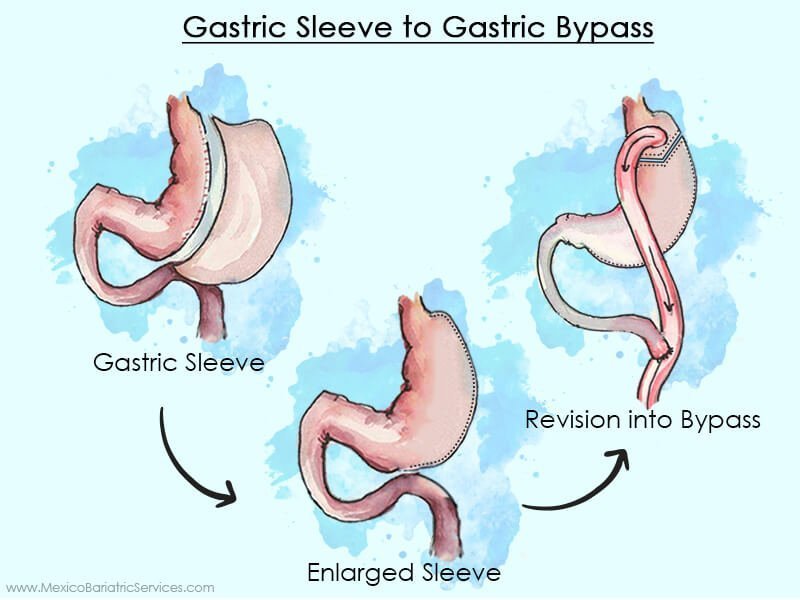
Success rate: Conversion to LRYGB is preferred in cases of dysphagia or gastroesophageal reflux disease.[13]Jens Homan, Bark Betzel, Edo O. Aarts
Secondary surgery after sleeve gastrectomy: Roux-en-Y gastric bypass or biliopancreatic diversion with duodenal switch
“Conversion to LRYGB is preferred in cases of dysphagia…”
View in Article
Risks: Rare leakage at Gastrojejunostomy (the joining between your stomach and intestine) may take place, that could lead to a reoperation of the revisionary surgery.
3. Sleeve Gastrectomy to Duodenal Switch
Sleeve Gastrectomy is a part of the Duodenal Switch procedure. In this procedure, a part of the small intestine is divided to bypass the Pancreatic and Bile drainage.
The advantage is that the Duodenal Switch significantly limits the amount of fat absorbed from the diet, which is responsible for weight loss and weight maintenance.
Success rate: A controlled study on patients who failed gastric sleeve and received second stage Duodenal Switch showed that it is an effective option for the management of suboptimal outcomes of sleeve gastrectomy (SG). An additional 41% excess weight loss and 35% remission rate for type 2 diabetes was also visible in the results.[14]Biertho L, Thériault C, Bouvet L
Second-stage duodenal switch for sleeve gastrectomy failure: A matched controlled trial.
“Second-stage DS is an effective option…”
View in Article
Risks: The procedure is technically complicated and time-consuming. Along with this, it is linked to more risks, which includes malnutrition and vitamin deficiencies.
4. Sleeve to Mini Gastric Bypass
A mini-gastric bypass (MGB) is also as one anastomosis gastric bypass (OAGB).
First of all, the gastric sleeve is dissected entirely, and the top portion of the stomach is stapled thoroughly to form a thin tube (usually 30 ml to 50 ml in size).
This tube acts as the new stomach which is sewn with a loop in the small intestine (at least 12 cm from the esophagogastric junction).
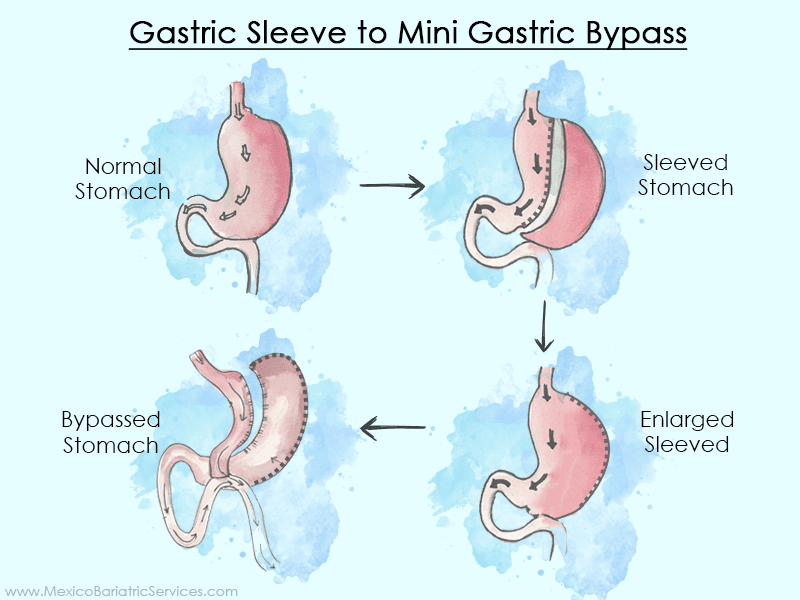
Success rate: This surgery bypasses the duodenum and approximately 150 cm to 200 cm of the bowel, which helps in weight loss. According to a study, a mean follow-up of 26 months demonstrated that the mean BMI was 31 kg/m2 and mean excess weight loss was 59.9%. It also concluded that this surgery is feasible and safe revision option.[15]Marie Cecile MC Blanchet
Laparoscopic conversion of sleeve Gastrectomy to mini-gastric bypass one-anastomosis gastric bypass
“After a mean follow-up of 26 months…”
View in Article
Risks: Some risks like perforated ulcers and hemorrhage may require surgery after mini-gastric bypass surgery.
Lap Band Conversion
A lap band is an adjustable band which is attached on the gastroesophageal junction of the stomach. This makes the person feel fuller even with lesser food consumption. However, in some cases, the band may slip from its place or may also erode inside the stomach.
Some common complications of lap band are:
- heartburn/reflux
- food intolerance
- esophageal dilation
- inadequate weight loss
Although these complications are not life-threatening, lap band revision Tijuana is usually preferred.
LAGB can be converted to gastric bypass, sleeve gastrectomy (SG), and duodenal switch to achieve additional weight loss.
Procedures:
1. Gastric Band to Sleeve Gastrectomy
If your stomach has dilated because of a faulty band, then the band is removed. After that, a gastric sleeve is formed, and the resected stomach is removed from the body.
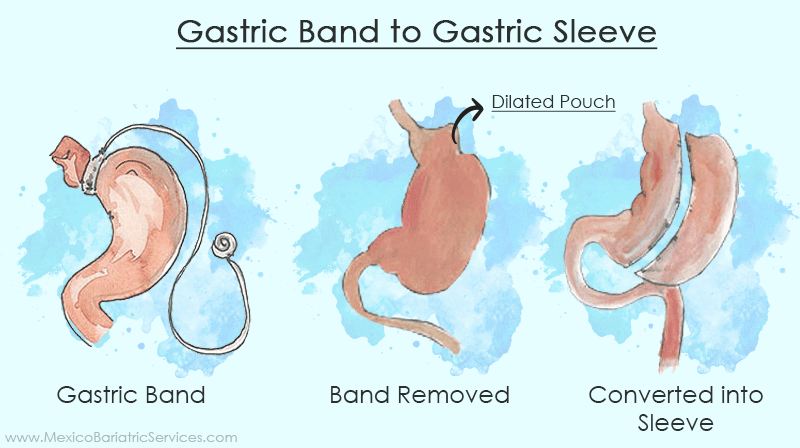
Success rate: A study conducted on patients who either had weight regain after LAGB or they were suffering from problematic symptoms due to a band migration. This study showed that conversion to sleeve from LAGB is a feasible option.[16]O.A.Khan, S.Mansour, S.Irukulla
Sleeve gastrectomy for gastric band failures – A prospective study
“Gastric band removal and revision sleeve…”
View in Article
Risks: A study compared 51,609 patients who underwent different kinds of primary and secondary bariatric surgeries from 2005 till 2011. It suggested that a band removal followed by sleeve gastrectomy offered more complications as compared to any other kind of primary or combination procedures.[17]Fernando Santos B, Wallaert JB, Trus TL.
Band removal and conversion to sleeve or bypass: are they equally safe?
“However, band removal with conversion…”
View in Article
2. Band to Gastric Bypass
When a person experiences gastric band malfunction, then the first step is to remove the band altogether.
The stomach is then bypassed using the Roux limb. Usually, these steps take place simultaneously. However, depending on the condition of the stomach, the bypass may be done after some months’ time.
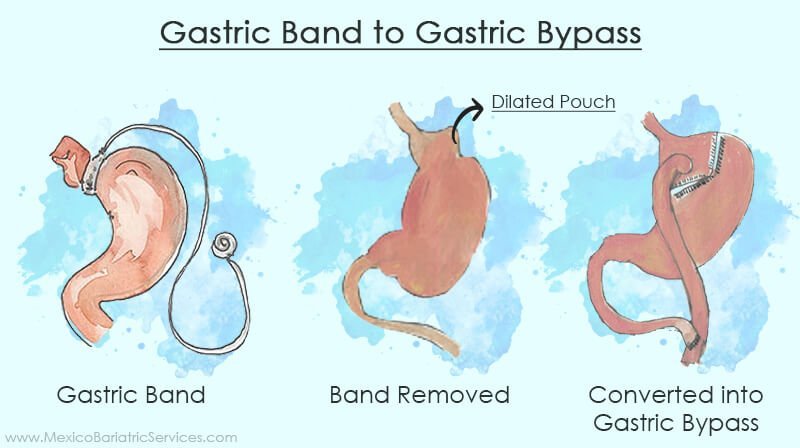
Success rate: According to a study,[18]Alexander Perathoner, Matthias Zitt, Monika Lanthaler
Long-term follow-up evaluation of revisional gastric bypass after failed adjustable gastric banding
“Findings have shown revisional gastric bypass to be a feasible bariatric procedure…”
View in Article revision to bypass has been recommended as a procedure resulting in long term desirable results after the failed gastric band.
Risks: Band removal with conversion to RYGB is not associated with higher morbidity or mortality compared to primary RYGB. It is a safe procedure but doesn’t show visible results until frequent re-operations.[19]Fernando Santos B, Wallaert JB, Trus TL.
Band removal and conversion to sleeve or bypass: are they equally safe?
“Band removal with conversion to RYGB is not associated…”
View in Article
3. Lap band to Duodenal Switch
After the band is removed, the doctor performs sleeve which is followed by the duodenal switch where a significant portion of the intestines is bypassed.
Success rate: A study on patients undergoing loop duodenal switch from a failed LAGB was conducted. It suggests that laparoscopic revision from lap band to duodenal loop switch is a safe alternative as compared to other types of surgeries.[20]Amit Surve, Daniel Cottam, Hinali Zaveri, Christina Richards.
Weight loss after conversion from laparoscopic band to loop duodenal switch
“Laparoscopically revision from Lap Band to Loop Duodenal Switch is safe and is more effective…”
View in Article
Risks: The same study suggests that although the surgery is technically challenging, if performed by an expert surgeon, then this procedure can result in superior weight loss.
4. Lap Band to Mini Gastric Bypass
It is essential to eradicate the lap band completely to prevent any extra pressure on the nearby tubes (stenosis). For this, the gastric greater curvature is freed, starting at proximal to the pylorus using LigaSure.[21]Roger Noun, Rita Slim, Ghassan Chakhtoura.
Resectional One Anastomosis Gastric Bypass/Mini Gastric Bypass as a Novel Option for Revision of Restrictive Procedures: Preliminary Results
“the gastric greater curvature was…”
View in Article
After band removal, the mini-gastric bypass is performed where only a single anastomosis is made.[22]Elinton Adami CHAIM, Almino Cardoso RAMOS, and Everton CAZZO
MINI-GASTRIC BYPASS: DESCRIPTION OF THE TECHNIQUE AND PRELIMINARY RESULTS
“The operation begins with the dissection…”
View in Article
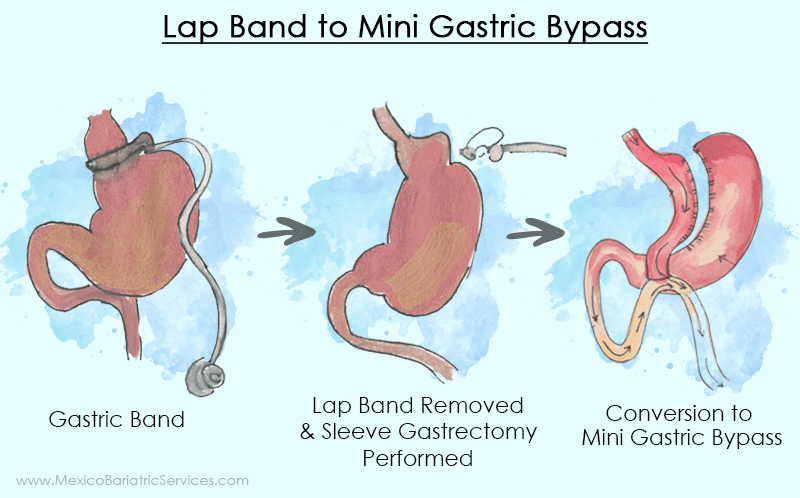
Success rate:- A study showed that conversion of failed lap band to mini-gastric bypass is a safe procedure. Patient satisfaction was high, and they showed rapid recovery.[23]Rutledge R
Revision of failed gastric banding to mini-gastric bypass.
“Conversion of failed LAGB to MGB was a safe…”
View in Article
Risks:- According to a detailed paper of conversion of Lap band to Mini-gastric bypass, an acceptable complication rate was observed. However, the time of transformation from a lap band to a mini bypass was considerably high as compared to first-hand mini bypass surgery.[24]Rutledge R
Revision of Lap-Band to MGB
“In our specialized center, one stage procedure…”
View in Article
Irreversible revisions:
There are some bariatric surgery procedures which can be reversed if need be. However, some surgeries are irreversible:
- Gastric Bypass– Although it is a reversible procedure, it involves a high risk to the patient’s life. Therefore, the surgeons do not prefer reversing the bypass. They would instead go for a “tune-up”.
- Gastric Sleeve– As half of the stomach is already removed during sleeve formation, therefore, a gastric sleeve cannot be reversed.
Surgery that Needs Most Revision
A study characterized the frequency of patients who underwent revision surgery and compared their outcomes with primary bariatric surgery clinic data.[25]Courtney Fulton, Caroline Sheppard, Daniel Birch, Shazeer Karmaliand Christopher de Gara
A comparison of revisional and primary bariatric surgery
” Figure 1 compares the proportion of primary procedures…”
View in Article
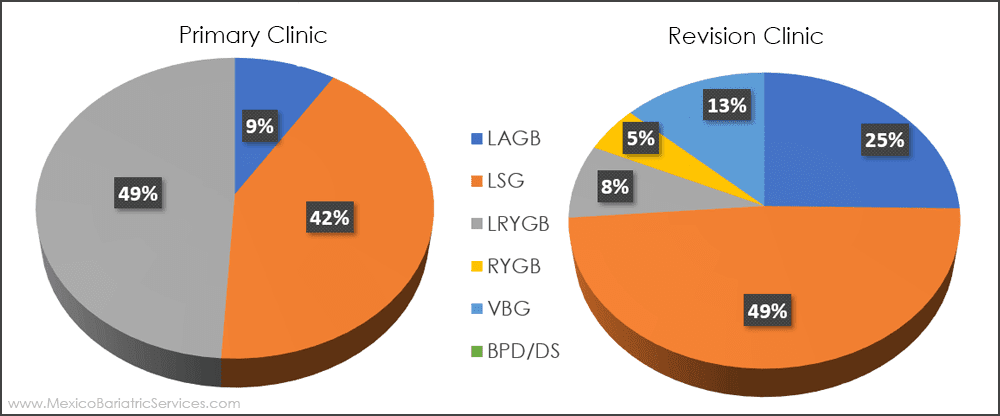
Is Your Revision Covered?
People are usually worried about their gastric bypass revision cost or gastric sleeve revision cost. Usually, insurance plans cover bariatric surgery which treats morbid obesity and have life-threatening conditions. But, when it comes to revision surgery, do not expect straight “yes’s” and “no’s” as you need to respond to the many “why’s” to your insurance providers.
Your insurance providers need:
- To know whether your previous surgery has actually failed or if you couldn’t comply with post-op requirements (like specific diet plans, exercise regime, etc.)
- Proofs for everything, so make sure you have your MRI’s, CT scans, endoscopies of the stretched pouch, failed staple line, band slippages, etc. in place.
What Causes Weight Regain?
- Lack of adherence to the post-op diet
- Lack of nutritional compliance
- Metabolic imbalance
- Physical inactivity
- Insufficient follow-ups
- Pre-existing nutritional deficiencies
No way would you go under the forceps to fail! We at Medical Tourism Corporation make Revision options available to you at a lower price and with no waiting times. It gives you a second chance of shedding those regained extra pounds.
Book your appointment now!
References:
1. Center for Surgical Weight Loss at Lake Norman. Revision and Conversion Surgery
2. Jirapinyo P, Kröner PT, Thompson CC. Purse-string transoral outlet reduction (TORe) is effective at inducing weight loss and improvement in metabolic comorbidities after Roux-en-Y gastric bypass
3. Vincenzo Bove. Transoral Outlet Reduction for Therapy of Weight Regain After Gastric Bypass
4. Chung-Yen Chen, Wei-Jei Lee, Hui-Ming Lee. Laparoscopic Conversion of Gastric Bypass Complication to Sleeve Gastrectomy: Technique and Early Results
5. Carter CO, Fernandez AZ, McNatt SS, Powell MS. Conversion from gastric bypass to sleeve gastrectomy for complications of gastric bypass
6. Obesity Action Coalition. Band over Bypass
7. Ibtisam Al-Bader, Mousa Khoursheed, corresponding author Khalid Al Sharaf, D. Ali Mouzannar, Aqeel Ashraf, and Abe Fingerhut. Revisional Laparoscopic Gastric Pouch Resizing for Inadequate Weight Loss After Roux-en-Y Gastric Bypass
8. Barham K. Abu Dayyeh, Pichamol Jirapinyo. Endoscopic Sclerotherapy for the Treatment of Weight Regain after Roux-en-Y Gastric Bypass: Outcomes, Complications, and Predictors of Response in 575 Procedures.
9. Bruder SJ, Freeman JB, Brazeau-Gravelle P. Lengthening the Roux-Y Limb Increases Weight Loss after Gastric Bypass: a preliminary report.
10. Manish Parikh, Michel Gagner. Laparoscopic Conversion of Failed Gastric Bypass to Duodenal Switch.
11. Marvin Ryou, Christopher C. Thompson. Current Status of Endolumenal Bariatric Procedures for Primary and Revision Indications.
12. Giovanni Cesana, Matteo Uccelli, Francesca Ciccarese. Laparoscopic re-sleeve gastrectomy as a treatment of weight regain after sleeve gastrectomy
13. Biertho L, Thériault C, Bouvet L. Second-stage duodenal switch for sleeve gastrectomy failure: A matched controlled trial
14. Marie Cecile MC Blanchet. Laparoscopic conversion of sleeve Gastrectomy to mini gastric bypass one-anastomosis gastric bypass
15. A.Khan, S.Mansour, S.Irukulla. Sleeve gastrectomy for gastric band failures – A prospective study
16. Fernando Santos B, Wallaert JB, Trus TL. Band removal and conversion to sleeve or bypass: are they equally safe?
17. Alexander Perathoner, Matthias Zitt, Monika Lanthaler. Long-term follow-up evaluation of revisional gastric bypass after failed adjustable gastric banding.
18. Amit Surve, Daniel Cottam, Hinali Zaveri, Christina Richards. Weight loss after conversion from laparoscopic band to loop duodenal switch.
19. Elinton Adami CHAIM, Almino Cardoso RAMOS, and Everton CAZZO. Mini-Gastric Bypass: Description of The Technique and Preliminary Results
20. Rutledge R. Revision of failed gastric banding to mini-gastric bypass
21. Rutledge R. Revision of Lap-Band to MGB
22. Courtney Fulton, Caroline Sheppard, Daniel Birch, Shazeer Karmaliand Christopher de Gara. A comparison of revisional and primary bariatric surgery.
23.Roger Noun, Rita Slim, Ghassan Chakhtoura, Joseph Gharios, ElieChouillard, and Carla Tohmé-Noun. Resectional One Anastomosis Gastric Bypass/Mini Gastric Bypass as a Novel Option for Revision of Restrictive Procedures: Preliminary Results

